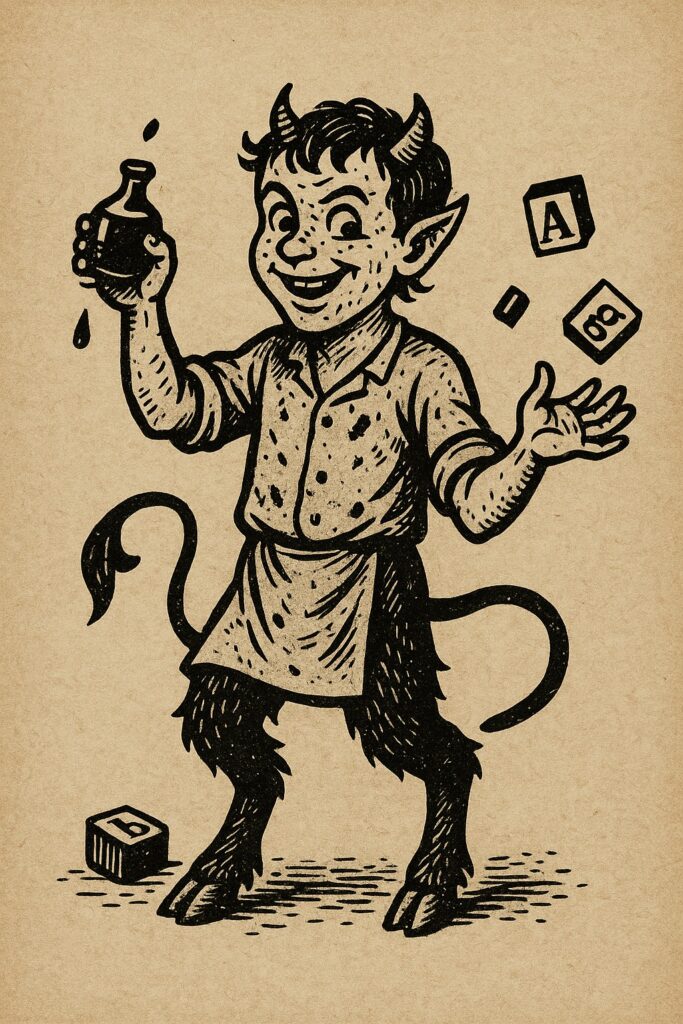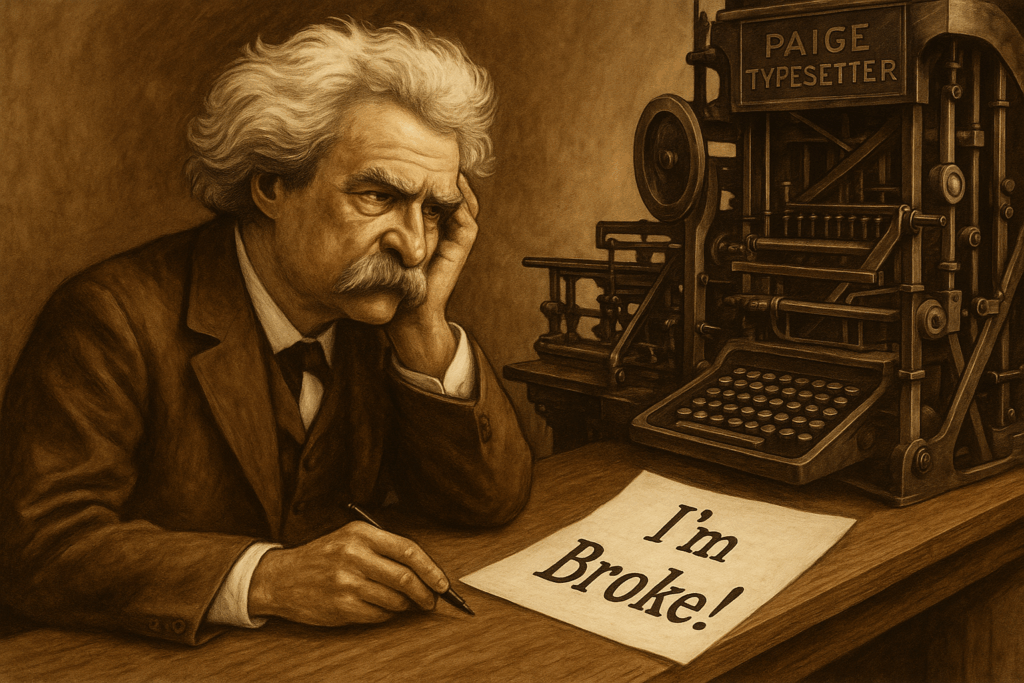“Marvelously ingenious and perfect, from a mechanical standpoint; worthless commercially, the costliest machine ever built will stand as a monument to Mark Twain’s vanished fortune.”
New York Evening Telegram, October 8, 1898
Mark Twain & The Paige Typesetter: A Cautionary Tale
The Paige Typesetter
The Invention
A mechanical marvel designed in the late 1800s to automate typesetting.
Contained over 18,000 moving parts — astonishingly complex.
Twain’s Bet
Samuel Clemens (Mark Twain) believed it would change publishing forever.
He invested $300,000+ (today’s equivalent: several million) — his own fortune plus much of his wife’s inheritance.
What Went Wrong
The machine was always “almost ready,” but never reliable.
Meanwhile, the simpler, cheaper Linotype quietly took over the market.
The Result
Twain went bankrupt in the 1890s.
To repay his debts, he endured an exhausting world lecture tour.
His Paige investment became a cautionary tale of brilliance undone by overconfidence.
Mark Twain once said, “I am not as young as I was several years ago, but I am as foolish as ever.” I feel you, Sam.
I recently finished Ron Chernow’s 1200 page biography about Mark Twain, entitled – wait for it – Mark Twain.
Although it exceeded my expectations by a lot, it in no way ended up being the book I thought it would be.
Chernow’s books are distinguished by their impeccable research coupled with the riveting storytelling of fiction. Chernow is best known for writing the book that inspired the Broadway sensation Hamilton, but should also be known for writing incredible biographies on George Washington and Ulysses S Grant, as well JP Morgan and John Rockefeller.
He is, in my humble opinion, the second greatest living biographer behind Robert Caro. All respect to Chernow, you can’t beat a guy that wrote 4 volumes on LBJ.
Or 1500 pages on Robert Moses, the man who built Manhattan, yet no one would know the story if not for Caro.
Back to Chernow, I figured this book, one about a larger than life American humorist – some say the greatest American humorist of all time – would be a deep dive into the life and writings of Mark Twain. And in many ways, it was.
What I did not account for was Twain’s lifelong struggles with money and the parallels to my own life.
Twain spent a lifetime chasing fast fortune via speculative deals and get rich quick schemes, always being a little off or a little late.
The California Gold Rush of 1849? Twain got there in 1851.
There were several examples like this, but nothing like his misadventures with the Paige Typesetter.

Twain lost most of his fortune investing in a machine called the Paige Typesetter, a technological marvel that was supposed to revolutionize printing. In the late 1800s, The Paige Typesetter was a brilliant but over-engineered machine with 18,000 parts.
Basically, it was like early AI. When it used to take 2 people to print books and newspapers, this machine reduced that to 1. Incidentally, the position that it rendered obsolete was the Printer’s Devil, easily the coolest job title ever.

He believed it would beat out the simpler Linotype and transform publishing. Instead, it consumed all his money and most of his wife’s inheritance. The Paige machine was always “almost ready,” but never reliable, and by the time it worked, the Linotype had already won.
Twain kept doubling down, convinced that the big payday was just around the corner. In the end, it bankrupted him.
The back third of the book is the section I was not expecting, the sad end to the fascinating life of a complicated man. Twain essentially fled America with his family (most of his family, won’t spoil that here) because he couldn’t bear the shame of his debt and bankruptcy. It was a sad end to a great life. It was also an end that they didn’t teach in school, not my school anyway.
It also got me thinking of exactly how I don’t want to end up.

I’ve lost a good chunk of mine chasing my own “Paige Typesetters” over the years — get-rich-quick trades, short-sighted career moves, financial decisions made with equal parts hubris and desperation.
That’s why the 1% Plan matters so much to me. It’s the antidote to my inner Twain.
My Paige Typesetters
Mine weren’t made of brass and steel, but the principle was the same.
I’ve walked away from steady jobs chasing something shinier.
I’ve gambled with trades, thinking 3% per week was better than 1%.
I’ve thrown good money after bad because I knew I could turn it around.
Each time I thought, this is the thing that will fix everything. Just like Twain believed the Paige would secure his legacy.
The 1% System
That’s why the 1% Plan is different. It’s boring. It’s incremental. It’s built not on a miraculous invention but on discipline:
- Start with $60,000.
- Earn 1% per week through covered calls, dividends, and index trading.
- Withdraw anything above the goal.
- Hit milestones: $100,000 (2025), $250,000 (2026).
Unlike Twain’s Paige, the 1% Plan doesn’t depend on perfection. It only fails when I fail — when I let ego or impatience push me past my own rules.
Why It Matters
For Twain, the Paige wasn’t just about money; it was about validation. He wanted to be seen as both a great writer and a great businessman. For me, the same demons are there: the kid with the briefcase, the young man chasing recognition, the professional always wondering if I measure up.
The 1% Plan isn’t just about getting to $10,000 a month. It’s about proving to myself that I can stay disciplined. That I can resist the siren song of another Paige. That maybe, finally, I’ve found the thing I’ve been searching for.
Closing Thought
Mark Twain lectured around the world to pay off the debts from his Paige misadventure.
To his credit, he paid every one of his debts. To his discredit, it would not be overstatement to suggest that both his daughter’s death – and his wife’s – were at the very least exacerbated by the stress and anxiety he caused.
I don’t want to lecture — I want to trade, to blog, to build slowly and steadily. And maybe by December 31, 2026, instead of standing on a stage like Twain, I’ll be standing on a solid foundation of my own making.
And if you were wondering whatever became of the Paige Typesetter? It never worked. But if you would like to see one, there is one model left on this Earth – at the Mark Twain House in Hartford, Connecticut.
